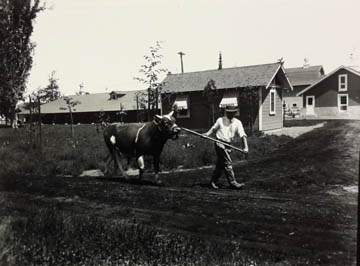
Many people think that the big green and white barn on Magnolia Road was the Edgemoor Polo Barn or the Edgemoor Dairy Barn.
That is incorrect.
The Edgemoor Farm, sometimes called the Edgemoor Stock Farm, was known worldwide as the greatest breeding farm for purebred stock. According to a 1920’s newspaper article in the San Diego Union, the Edgemoor Stock Farm in Santee, CA was established in 1908 by Walter Dupee and his father John.
The farm consisted of 680 acres with buildings and equipment “as up to date as modern science can make them.” Edgemoor Farm housed 600 head of the greatest Guernsey breeders and the highest prize winners. Mr. Dupee credited Dr. JA Woodside, “his advisor and veterinarian” for helping develop the herd.
Mr. Dupee said that at one time he produced milk for retail, but it was a money losing proposition. The demand for “high test milk” was not great enough to warrant his continuing to sell milk. He made much more money breeding and selling Guernsey bulls. He sold one bull for $32,000 (about $420,000 in today’s money) and had one bull in his barn valued at $50,000 (about $653,000 in today’s money).
In addition, Edgemoor had great breeding stock in pigs. The Dupee’s bought one boar at $8,000 (about $104,000 in today’s money) and another at a mere $2,000 ($26,000 in today’s money) to enrich their breeding stock of boars. Edgemoor Farm was breeding the “smooth, stretchy, soft-sided type of pig”.
The Dupee family’s emphasis on breeding made the Edgemoor Farm famous.
In November 1921, the Dupee family sold the farm to the president of the Cuyamaca National Bank, GL Stroeback who wanted to make the farm successful as a dairy rather than a breeding farm. In return, The Dupee’s bought from Stroeback the Casa Grande Apartments on Park Blvd and University. The Casa Grande Apartments were supposed to be the best apartments in California at that time. Unfortunately, these apartments no longer exist.
Edgemoor as a Home for the aged and Indignant
Following the Edgemoor Farm’s glory days as the Edgemoor Stock Farm, the County of San Diego purchased the property from Godfrey L. Strobeck for use as a “last resort” home for the aged and indigent in 1923. It was one of the last poor farms (or farm homes) established in the United States prior to the Great Depression and the introduction of Social Security. By the mid-1920’s the Edgemoor cared for 520 people. Throughout the years the County added new buildings; in 1950 apartments and wards were added. In 1953 the County of San Diego discontinued the farm, dairy operations and planned renovation of the barn. Two years later the place name was changed to Edgemoor Geriatric Hospital.
Edgemoor as a Geriatric Hospital Other buildings were demolished in 1957, 1959, 1960 and 1966, and a new hospital building was erected in 1966. The former milking barns were converted to living quarters. All of the original buildings of the Edgemoor Farm, including the Williamson Ranch House and the Dupee Ranch House are gone. A series of financial problems, facility issues, and basic care of patients, led to the decision to close Edgemoor Geriatric Hospital. The closure would facilitate the building of a new Edgemoor Hospital capable of, caring for, future generations of patients. The new facility opened January 23, 2009. Unfortunately the decision was made to demolish all the old buildings on the Edgemoor property except for one: the Dutch gambrel roof barn, built in 1913.
Other buildings were demolished in 1957, 1959, 1960 and 1966, and a new hospital building was erected in 1966. The former milking barns were converted to living quarters. All of the original buildings of the Edgemoor Farm, including the Williamson Ranch House and the Dupee Ranch House are gone. A series of financial problems, facility issues, and basic care of patients, led to the decision to close Edgemoor Geriatric Hospital. The closure would facilitate the building of a new Edgemoor Hospital capable of, caring for, future generations of patients. The new facility opened January 23, 2009. Unfortunately the decision was made to demolish all the old buildings on the Edgemoor property except for one: the Dutch gambrel roof barn, built in 1913.
Edgemoor as a Historic Registered Site
On April 17, 1985 a formal Nomination was sent to the National Park Service, to register the Edgemoor Farm Barn as a historic site. On May 16, 1986 The Barn was added to the National Registry of Historic Places. In the following years the Barn’s address was changed from 9064 Edgemoor Drive to it’s current address and of 9200 N. Magnolia Ave. The Edgemoor Barn is currently owned by the County of San Diego, and the first floor of the Edgemoor barn is license to the Santee Historical Society for use as an active museum and the office of the Santee Historical Society.
